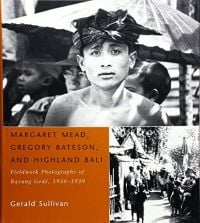Margaret Mead, Gregory Bateson, and Highland Bali: Fieldwork Photographs of Bayung Gede, 1936-1939
- Title
- Margaret Mead, Gregory Bateson, and Highland Bali: Fieldwork Photographs of Bayung Gede, 1936-1939
- Original language
- English
- Author(s)
- Illustrator(s)
- Publisher
- University of Chicago Press
- ISBN
- 9780226384344
- Publication date
- 1999
- Subjects
- bali culture
- anthropology
- Find Book
- Amazon.com
- Related Env. Initiatives
- Related Places
- Related Biographies
- Related Children's Books
- Related Holidays
- Related Folktales
- Related Comics
- Related Lontar
- Linked words
Description(s)
In 1936 anthropologist Margaret Mead and her husband, Gregory Bateson, retreated from lowland Bali, which was the focal point of much scholarly and tourist activity, to the remote village of Bayung Gedé in the island's central highlands. Although they wrote relatively little about their work in this place, which Mead called "our village, way up in the mountains, a lovely self-contained village," they did leave behind a remarkably rich and extensive photographic record of their time there. Margaret Mead, Gregory Bateson, and Highland Bali includes 200 photographs that the couple took between 1936 and 1939, the vast majority of which have never before been published. They vividly capture the everyday lives of the men, women, and children of Bayung Gedé, their homes and their temples, and many other fascinating details of village life not featured in Mead and Bateson's publications. In a substantial introductory essay, Gerald Sullivan, who selected the photographs, uses excerpts from fieldnotes and correspondence to illuminate Mead and Bateson's ethnographic work. Tracing the project from its inception in their proposals to the publication of their work, Sullivan shows how they used the photographs both as fieldnotes and as elements in their theoretical argument. Finally, he explores what the photographs reveal—independently of Mead and Bateson's project—about the Balinese character to the contemporary viewer. The result is a both a substantial contribution to visual anthropology and an invaluable supplement to the published works of Margaret Mead and Gregory Bateson.



Enable comment auto-refresher